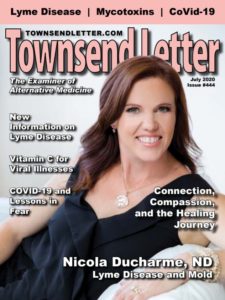Borrelia burgdorferi Found In Breast Milk
Currently studies are showing that that Borrelia burgdorferi can be found in the breast milk, as breast milk from infected mothers has detected spirochetes that can be detected by PCR and grown in culture.13 However, more research needs to be done on whether B. burgdorferi can be transmitted through the breast milk to their baby. Another study in the FDA Science Forum documented transmission via breast milk of B. burgdorferi from experimentally infected mating pairs to offspring in a murine model.14
Gestational Lyme Disease in Animals
The maternal-fetal transmission of B. burgdorferi has been documented not only in humans but also in horses, coyotes, cows and Peromyscus leucopus (white-footed mouse).14,15 A study reports that intrauterine transmission can occur through dogs as well. A female dog infected with B. burgdorferi delivered puppies, and at six-weeks-old they came up positive for B. burgdorferi through DNA detected in their tissues.16
Another study reports:
B. burgdorferi can cause in utero infections in horses and can be associated with foal mortality. The kidney lesions in the foals that died soon after birth and, in the yearling, contributed to the deaths of the animals. The lesions were attributed to B. burgdorferi infection as B. burgdorferi was isolated from the kidneys of three of the four animals and spirochetes were identified in the kidneys of histologic sections.17
Active Lyme During Pregnancy
Often women who are pregnant with active Lyme experience a reduction in symptoms. However, we are unsure as to exactly, why this occurs. A study done on mice shows that during pregnancy in a murine model, the severity of pathogenic inflammatory response associated with Lyme arthritis is significantly attenuated.18 One of the commonly observed effects on immune responses during pregnancy has been a bias toward humoral responses, frequently at the expense of cell-mediated immunity and related inflammatory sequelae. In this study the changes are correlated with an altered tryptophan metabolism and progesterone-mediated alterations in the balance of cytokine elaboration. However, the intricate cytokine balance among the host response to infection and maintenance of pregnancy may also work against the fetus in some cases.18 “Clinical observations in humans suggest that the severity of rheumatoid arthritis is ameliorated during pregnancy, whereas systemic lupus erythematosus, in which the principal pathology is associated with autoantibody production, may become exacerbated during gestation.”18
However, in this study done with pregnant mice, the results show that pregnancy changes the equilibrium of cytokine expansion to decrease the pathogenic inflammatory response from an infectious challenge. This down-regulation of Th1 responses, likely due to progesterone-mediated upregulation of Th2 cytokine production, provides a reasonable explanation for the significant reduction of Lyme arthritis in pregnant mice. That said, the study did not detect substantial differences in spirochetal tissue burden amongst pregnant and nonpregnant controls.18 Further research surrounding the immune response in pregnant mice and in other infectious models may be useful for understanding the foundation of the profound immunologic changes involved with pregnancy. The 2018 Tickborne Disease Working Group report to Congress has also identified that, “hormonal changes during pregnancy can lead to changes in immune function that may affect the detection of clinical or laboratory findings.”19
Objective
It is transparent that through the past 35 years there has been enough documentation verifying transplacental transmission, and having organizations acknowledge this opens the door to constructively collaborate on research that needs to be done to determine solutions. On December 20, 2019, a letter was sent to Anthony S. Fauci, MD, Director of National Institute of Allergy and Infectious Disease (NIAID), requesting information about the Lyme disease research and coordination programs at the National Institute of Allergy and Infectious Disease (NIAID ) to strengthen local responses, improve clinical efficacy, and implement strategies to prevent the spread of Lyme disease. The letter states that, “To help us better understand how NIAID is approaching the health threat of Lyme Disease, they ask to provide answers to a list of questions.”20 Number two on the list is “What is NIAD conducting to better understand modes of transmission for Lyme disease? What research is the agency planning to conduct or incentivize to improve understanding of modes of transmission including vertical transmission?”20 This letter was written and signed by United States Senators, Edward J. Markey, Susam M. Collins, Robert Menedez, Chris Van Hollen, Elizabeth Warren, Angus S. King Jr, and Richard Blumenthal.
Moving forward, research and urgent investigation of gestational Lyme disease is crucial and requires a reconstructed multi-disciplinary approach, including an evidence based inclusive model involving clinical researchers, physicians, and patients with lived experience to be valued members of the research team.
Next Steps in Research, Study, and Solutions
• Retrospective questionnaires and surveys on Lyme disease and coinfections (specifically babesia, bartonella, and ehrlichiosis)
• Assess short- and long-term results (miscarriages, stillbirths, infants) of pregnancies involving tick-borne infections
• Large-scale long-term prospective follow-up studies with both the mother and her baby to identify maternal cofactors correlated to maternal-infant transmission
• Large-scale long-term prospective follow-up studies for maternal and infant outcomes, including occurrence of possible early and late stage sequelae of congenital Lyme borreliosis
• Early diagnostic methods to determine Borrelia-infected infants
• B. burgdorferi-specific evaluation of any fetal or neonatal death21
• Studies determining whether B. burgdorferi can be transmitted from mother to child through breast milk
• Animal models
• Studies to determine the optimum course and duration of treatment for women wishing to become pregnant who have received successful treatment for clinical symptoms of tick-borne infections
• Studies showing the rate at which women who were in remission relapse with symptoms from tickborne infections after giving birth and ways to help prevent that.
Now is the time, more than ever, to come together and determine solutions that will work towards preventing more miscarriages, stillbirths, and babies born with tick-borne illnesses potentially causing chronic debilitating health issues. As Sue Faber, RN, co-founder and president of LymeHope, states: “Despite this failed framework, I still have great hope that this isn’t the end of the story, but rather a fresh beginning, a reawakening to the reality of the Lyme crisis, which continues to sweep across our nation. Your decisions and actions on this issue will directly impact the fate of millions.”22
About Michelle McKeon, MS, CNS

Michelle McKeon is a Clinical Nutritionist who specializes in detoxification, tick-borne diseases, gut dysbiosis, and inflammatory conditions. She has been guiding both local and long-distance clients through addressing various factors that are causing their symptoms. Michelle looks for these answers through exploring mold mycotoxins, genetic/methylation issues, heavy metals, tick-borne infections, cell membrane damage, parasites and viral infections, dental issues, diet, and gut flora. Michelle was introduced to functional medicine after her personal struggle with a debilitating battle of Lyme disease. She sought out hyperthermia treatment and detoxification therapies. This treatment saved her life, and for the first time she was able to see a light at the end of the tunnel. From this experience, she decided to go back to school to receive a Master’s Degree in Human Nutrition at the University of Bridgeport. Since recovering, Michelle is the owner and operator of Lyme and Cancer Services and her Nutrition Practice, Balancing Pathways. She has authored two Ebooks, and advocates for people with health conditions, through writing articles for health magazines and speaking at conferences and support groups. Her hope is to not only support people in their healing journey, but to create a foundation for them to effectively become their optimal selves: physically, emotionally, mentally, and spiritually.









